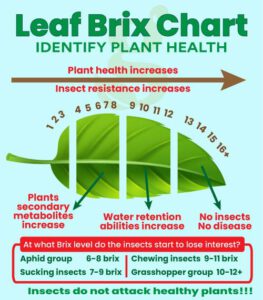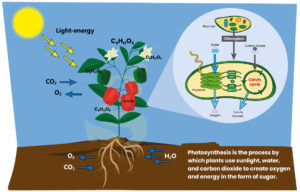
Brix in relation to crop health and quality
Brix in relatie tot gezondheid en kwaliteit van gewassen. De zoete wetenschap van Brix. Brix in relatie tot gezondheid en kwaliteit van gewassen. Brix-waarde verwijst
More yield from better quality
All in just 5 products
25+ years of fertilizer experience
Better and cheaper
Easy to use
Biostimulants are the latest applications in improving fertilisers. Thanks to the latest European legislation, it is possible to add them to fertilisers. However, the claims that can be made are still limited.
Triacontanol is a fatty alcohol found in several plant crops, including alfalfa. It has gained attention for its unique ability to stimulate plant growth and development. Numerous studies have shown that triacontanol can enhance photosynthesis, nutrient uptake and overall plant vigour, leading to higher yields.
Photosynthesis is the fundamental process by which plants convert light energy into chemical energy, ultimately allowing them to grow. Triacontanol is known to improve the efficiency of photosynthesis by increasing chlorophyll content in plants. Scientific studies, such as those conducted by Liu et al. (2015) [1], have shown the positive impact of triacontanol on chlorophyll synthesis, resulting in improved photosynthetic rates and increased biomass production.
Nutrient uptake efficiency is crucial for plant health and productivity. Triacontanol has been found to improve plant nutrient uptake, especially in the case of essential elements such as nitrogen, phosphorus and potassium. Research by Zhang et al (2018) [2] highlights the role of triacontanol in promoting the expression of genes related to nutrient transporters, leading to increased uptake and utilisation of nutrients by plants.
Besides promoting growth, triacontanol has been reported to improve a plant's ability to withstand various environmental stresses, such as drought, salinity and temperature extremes. Scientific reports, such as the work by Li et al. (2017) [4], suggest that triacontanol induces the expression of stress-related genes, making the plant more resistant to adverse conditions. This aspect of stress tolerance becomes particularly relevant in the context of climate change and the increasing unpredictability of weather patterns.
Although triacontanol has remarkable effects on its own, its combination with fertilisers has shown even more promising results. When used together with traditional fertilisers, triacontanol acts as a catalyst that enhances the effect of dietary supplements. Studies conducted by Wang et al. (2020) [3] showed that the combined application of triacontanol and fertiliser resulted in significantly higher crop yields compared to the use of fertiliser alone. This synergy is attributed to the ability of triacontanol to make nutrient uptake more efficient, allowing plants to make optimal use of the added fertilisers.
Integrating triacontanol from alfalfa with fertilisers enriches existing fertilisers. It enhances plant growth, photosynthesis and nutrient uptake and works with fertilisers for higher yields of higher quality. This is why we at Gen1:11 have added this special extraction from Alfalfa to some of our products. These are: Gen1:11 Early Flower, Gen1:11 Bloom Big and the Gen1:11 Foliar Bliss. Triacontanol can actually be used during any stage of growth and flowering. With Gen1:11, we chose to use it during early flowering and during flower maturation. This gives you a richer bloom with bigger flowers and tastier fruits.
Many researchers have now reported the positive role of TRIA in improving growth, yield, photosynthesis, nitrogen fixation, enzyme activities, free amino acids, reducing sugars and soluble protein of plants. Below are just some of the many studies.
Ries , S . 1991 . Triacontanol and its second messenger 9-β-L(+)-adenosine as plant growth substances . Plant Physiol , 95 : 986 – 989 .
Nagoshi , T and Kawashima , S . 1996 . Effect of foliar application of triacontanol on growth and yield of rice plants. IV. Effect of triacontanol on the ripeneing of rice plants under shading and low temperature conditions . Japan J Crop Sci , 65 : 437 – 444 .
Borowski , E , Blamowski , ZK and Michalek , W . 2000 . Effects of tomatex/triacontanol on chlorophyll fluorescence and tomato (Lycopersicon esculentum Mill.) yields . Acta Physiol Plant , 22 : 271 – 274 .
Naeem M, Khan MMA, Moinuddin , Siddiqui MH. 2009 . Triacontanol stimulates nitrogen-fixation, enzyme activities, photosynthesis, crop productivity and quality of hyacinth bean (Lablab purpureus L.) . Sci Hort 121 : 389 – 396 .
Idrees , M , Khan , MMA , Aftab , T and Naeem , M . 2010 . Synergistic effects of gibberellic acid and triacontanol on growth, physiology, enzyme activities and essential oil content of Coriandrum sativum L . The Asian Australasian J Plant Sci Biotechnol , 4 : 24 – 29 .
[1] Liu, W., Fu, Y., Hu, G., Si, H., Zhu, L., & Wu, L. (2015). Triacontanol enhances growth of rice (Oryza sativa L.) by improving photosynthesis and chlorophyll synthesis. Crop Journal, 3(4), 316-324.
[2] Zhang, J., Li, B., Yang, Y., Liu, J., Chen, X., & Lu, Y. (2018). Triacontanol regulates nitrogen metabolism and increases tolerance to ammonium stress in rice. Scientific Reports, 8(1), 1-12.
[3] Wang, H., Li, Y., Qin, Y., & Shi, Y. (2020). Effects of triacontanol on rice yield and nitrogen-use efficiency under different nitrogen regimes. Frontiers in Plant Science, 11, 187.
[4] Li, L., Liu, J., Wang, Y., Zhang, X., & Zhang, H. (2017). Exogenous triacontanol affects the antioxidant defense system and ion balance in Medicago sativa L. under saline-alkaline stress. Frontiers in Plant Science, 8, 788.

Brix in relatie tot gezondheid en kwaliteit van gewassen. De zoete wetenschap van Brix. Brix in relatie tot gezondheid en kwaliteit van gewassen. Brix-waarde verwijst

Het endocannabinoïde systeem begrijpen Een korte handleiding voor CB1- en CB2-receptoren Het endocannabinoïde systeem (ECS) speelt een fundamentele rol bij het reguleren van verschillende fysiologische

Photosynthesis Photosynthesis is the process by which green plants, algae and some bacteria convert light energy into energy in the form of glucose. This process mainly takes place

7 handy tips to prepare for the new garden season Gardening tasks when the spring jitters strike: Spring is a time of renewal and

The development of hydroponic fertilisers through the ages The history of hydroponics is a story of innovation and perseverance, rooted in the quest of the

Creating a successful indoor grow involves more than just light and water. Here are 7 tips to boost your indoor garden.
Brix in relatie tot gezondheid en kwaliteit van gewassen. De zoete wetenschap van Brix. Brix in relatie tot gezondheid en kwaliteit van gewassen. Brix-waarde verwijst
Het endocannabinoïde systeem begrijpen Een korte handleiding voor CB1- en CB2-receptoren Het endocannabinoïde systeem (ECS) speelt een fundamentele rol bij het reguleren van verschillende fysiologische
Photosynthesis Photosynthesis is the process by which green plants, algae and some bacteria convert light energy into energy in the form of glucose. This process mainly takes place
7 handy tips to prepare for the new garden season Gardening tasks when the spring jitters strike: Spring is a time of renewal and
The development of hydroponic fertilisers through the ages The history of hydroponics is a story of innovation and perseverance, rooted in the quest of the
Creating a successful indoor grow involves more than just light and water. Here are 7 tips to boost your indoor garden.
Home » The added value of triacontanol (TRIA) in fertilisers

Because growing your own is a craft. It takes time, energy, focus, attention, maybe even love. At your own pace, in your own environment. You are the creator.